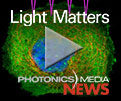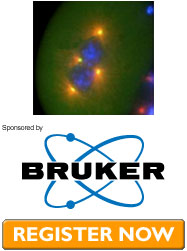


|
Neuroscience Drives Advances in Lasers For Multiphoton Imaging
The need for deeper, sharper in vivo imaging is providing the momentum for this approach to studying neural interactions. Neuroscience has become the key application for multiphoton microscopy because of its multi-billion-dollar funding level and the technical requirement to provide neuronal images in the cortex of living animals. Besides the fundamental drive to better understand how the brain processes information, from the synaptic to the network level, increased life expectancy brings an emphasis on improved quality of life in old age and a need for a better understanding of how to reduce and treat age-related mental impairments such as Alzheimer’s and Parkinson’s.
|
|
|
|

VCSEL-Based Imaging System Monitors Brain Activity
The agile operation and fast response times of these sources enable multimodal imaging of epilepsy, strokes and other brain disorders. Optical imaging techniques play a major role in daily biological research. While current applications focus on in vitro diagnosis and preclinical animal studies, new imaging techniques can also be used in clinical settings to study the brain in action. High spatial and temporal resolution has made optical imaging a desirable alternative to commonly used high-cost clinical imaging techniques such as functional MRI, single-photon emission computed tomography, or positron emission tomography.
|
|
|
|

Optical Filters Improve Precision, Accuracy for Neuroscience
Optogenetics and other neurobiology applications benefit from advances in optics. Optogenetics holds great promise for ailments such as migraines, blindness or neurological disorders through the interaction of opsins and light. Improvements in filters and other optical components will help in the understanding and treatment of these and other disorders. Opsins and other specific proteins have the ability to transduce light into an electrochemical signal. These proteins, typically found in photoreceptors in the eye, can be genetically modified to be expressed in neurons in the brain.
|
|
|
|


|
In this edition of the industry's premier weekly newscast: photons on demand enable compact optical chips, a spinning-disk microscope peers deeply into a cell, and narrow-spectrum UV light may reduce surgical infections. Hosted by Photonics Media's Melinda Rose.
|
|
|

Laser-Controlled Switch Turns Blood Clotting On, Off
Natural clotting is produced by a long cascade of protein interactions, culminating in the formation of fibrin, a fibrous protein that seals wounds. Surgery, wound healing and other conditions require manipulation of this process, typically through the use of anticoagulants such as heparin and warfarin. Administering blood thinners reduces clotting, but reversing their effects is difficult.
|
|
|
|

Tweaks Turn Microscope Into Billion-Pixel Imager
The physical limitations of microscope objectives have hindered improvements to conventional microscopes for several years. Microscope makers have tackled these limitations by using ever-more-complicated stacks of lens elements in microscope objectives to mitigate aberrations. Even so, the physical limitations have forced a trade-off between high resolution with a small field of view, or low resolution with a large one.
|
|
|
|



|
emlCCD Camera
Princeton Instruments
Princeton Instruments has launched emICCD technology for its PI-MAX4 camera platform, combining the advantages of intensifiers and EMCCDs to provide single-photon sensitivity and quantitative performance for scientific imaging and spectroscopy applications.
More info >>
|
|
 |

|
Vibration-Isolating Table
Newport Corp.
Newport Corp. has expanded its line of Integrity VCS vibration isolating optical tables with 40 3-ft-wide standard models with 6- or 8-ft standard-length options.
More info >>
|
|
 |

|
MFC-2000 Focus Controller
Applied Scientific Instrumentation
The MFC-2000 focus controller by Applied Scientific Instrumentation provides high-resolution, highly repeatable control of the Z-position of the microscope stage. Control is achieved using a closed-loop DC servomotor employing high-resolution encoders for positioning feedback.
More info >>
|
|
 |

|
Optical Filters
Iridian Spectral Technologies Ltd.
Iridian Spectral Technologies Ltd. has enhanced its line of optical filters with 405-nm laser line and long-pass filters that enable users to see more signal with less background in applications including machine vision, high-resolution printing, metrology, fluorescence and spectroscopy.
More info >>
|
|
 |


WEBINAR

|
Adaptive Optics for Microscopy

Wednesday, October 23, 2013 1 p.m. EST/10 a.m. PST

FREE WEBINAR


Peter Kner
|
 |
Enabling Structured Illumination Microscopy in Thick Tissue with Adaptive Optics
Peter Kner, University of Georgia
|

Joel Kubby
|
 |
Adaptive Optical Microscopy Using Direct Wavefront Sensing
Joel Kubby, Professor & Chair, Electrical Engineering Department, Baskin School of Engineering, University of California, Santa Cruz
|
|
|
|

Neuroscience 2013 - November 9 - 13, 2013 · San Diego, CA
Visit Photonics Media at Booth 117
|


|
Neuroscience 2013 is the premier venue for neuroscientists to present emerging science, learn from experts, forge collaborations with peers, explore new tools and technologies, and advance careers. Join more than 30,000 colleagues from more than 80 countries at the marketplace of ideas and tools for global neuroscience.
MORE INFO >>
|
|

|

|


Follow Photonics Media on Facebook and Twitter
|
 

|
|

sponsor
 |

sponsor
 |

sponsor
 |

sponsor
 |

sponsor
 |


|